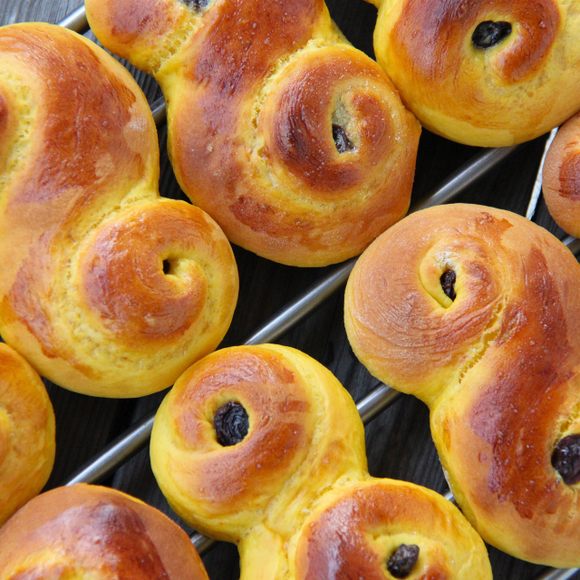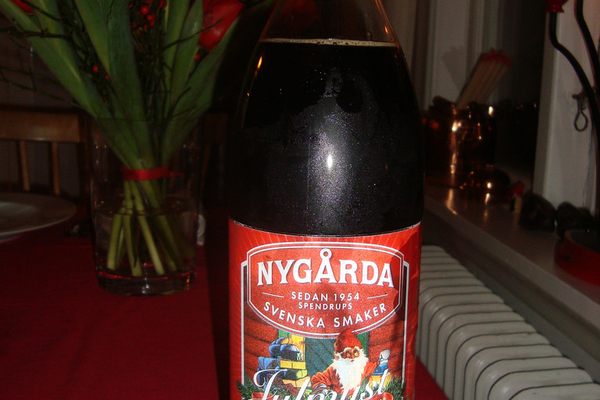If visiting Sweden in December, you will see curled saffron buns everywhere you go. These are lussekatter and they’re not just for eating; they were once believed to ward off the devil.
These traditional treats are associated with Luciadagen (“Lucia Day”). Celebrated on December 13, Luciadagen features choirs of children that accompany a leader dressed as Saint Lucia in singing the darkness away and calling for spring. Most aspects of the festivities celebrate light, particularly the candle-lined wreath crown that St. Lucia wears. Like many winter celebrations, Lucia Day blends Christian and pagan practices. Prior to the conversion to the Gregorian calendar, December 13 was the longest night of the year, a time when singing and lighting bonfires were necessary to drive away darkness and nefarious spirits. After Sweden’s conversion to Christianity around the 12th century, legends surrounding St. Lucia (a figure also associated with light) were incorporated into the tradition.
The buns that go with this traditional celebration are S-shaped and have a single raisin in the center of the two spirals. It is thought that they were originally modeled after a sleeping cat, an animal that was once associated with the devil; however, because they were made with saffron, a spice that was believed to have magical properties (not to mention a bright, sunny color), the treats were thought to actually be an effective way to ward off Satan. Originally, the buns were called djävulskatter (“devil cats”), but later the name changed to the more polite lussekatter (“Lucia cats”).
The dough is sweet and soft, but spiced with a generous amount of saffron to make it bright yellow. This gives the buns their unique smokey taste that goes well with the sweetness of the dough. The buns cost between 50 cents and $2 depending on where you buy them.
Written By
 CoolCrab
CoolCrab
Sources
- sweden.se/culture-traditions/lucia/
- www.thelocal.se/20181212/swedishchristmas-why-lussekatter-are-one-hell-of-a-bun-dec12
- semiswede.com/2011/12/13/lucia-and-lussekatter/
- sweden.se/society/10-fundamentals-of-religion-in-sweden/
- www.smithsonianmag.com/arts-culture/lussekatter-and-cuccia-for-st-lucys-day-26001669/
- www.britannica.com/topic/St-Lucias-Day
- www.nytimes.com/1993/12/12/nyregion/on-st-lucia-s-day-a-festival-celebrates-the-triumph-of-light.html
- www.npr.org/sections/thesalt/2016/12/23/506448946/in-sun-starved-sweden-bright-yellow-saffron-spices-up-winter
- books.google.com/books?id=_EA5AgAAQBAJ&pg=PT165&lpg=PT165&dq=lussekatter+lucifer&source=bl&ots=wEXA7imQHt&sig=3npXQqYFdliapomVsRl6R29_L0s&hl=en&sa=X&ved=2ahUKEwjqoMmGy53fAhWwct8KHbc-CNY4ChDoATAJegQIChAB#v=onepage&q=lussekatter%20lucifer&f=false
- books.google.com/books?id=RVEp3T5TLu4C&pg=PA69&lpg=PA69&dq=st+lucia+blinded&source=bl&ots=aGeGebWj7t&sig=YrgXLS-Tu5WutIoYmTEpyuT9nBA&hl=en&sa=X&ved=2ahUKEwiXoIz-0Z3fAhVLhOAKHSJBDkk4ChDoATAHegQIAhAB#v=onepage&q=st%20lucia%20blinded&f=false













